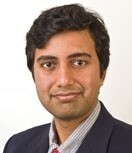Study suggests strategies to ease effects of primary care doctor shortage
by
Olga Deshchenko, DOTmed News Reporter | July 06, 2010

Hari Balasubramanian,
a systems engineer,
led the study
A mix of scheduling and other management strategies can improve continuous patient access to their primary care physicians by 40 percent, according to a new study by researchers at the University of Massachusetts Amherst.
The study, led by the university's assistant professor of industrial engineering and systems engineer, Hari Balasubramanian, also found that the suggested changes decrease the number of days patients wait for an appointment by up to 44 percent over baseline, cutting down the wait time from the average four to two days.
"We found that reorganizing the practice by reassigning patients from one physician to another or changing their panels actually improves timely access and continuity for patients with his or her own physician," Balasubramanian told DOTmed News.
For the study, the researchers looked at the data on physician work schedules and patient appointments at the Mayo Clinic in Minnesota for the years 2004 to 2006. Using the data from a 39-physician primary care group, the researchers analyzed wait times and continuity of care of more than 20,000 patients.
The researchers designed a computerized simulation of how the practice works.
"We built a computer model that mimicked this appointment system and then we decided to change the composition of the physician panels," said Balasubramanian. "Some physicians were overburdened, they have too many patients, and therefore, there are patients who were not able to get timely access and they typically ended up seeing somebody else," he said.
The study grouped the patients by gender and 14 different age groups. Researchers found that older patients tend to see their primary care physician more frequently than patients younger than 35 years of age, regardless of gender. However, there is difference among men and women.
"The number of appointments requested by females tends to be slightly higher than those requested by males," Balasubramanian said.
The study suggests that it's not just about the number of patients a primary care physician has, it's also about the type of patient, explained Balasubramanian. In order to provide timely and continuous care, doctors should shift some of their patients to other physicians in their practice.
"That is very difficult to do in practice because there's an already established relationship but over time, you may be able to do it," Balasubramanian said. "That's why a computer model is useful, because it allows you to test something without actually doing it in practice."
